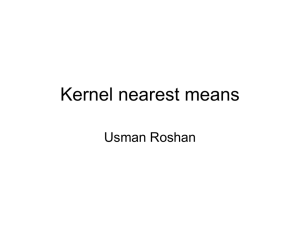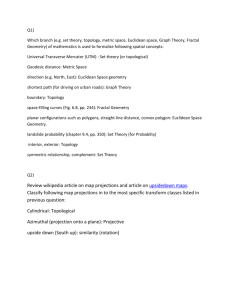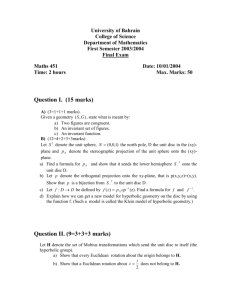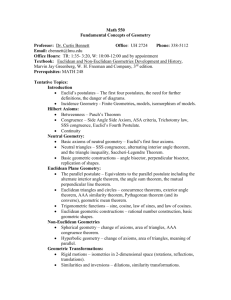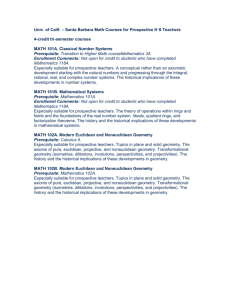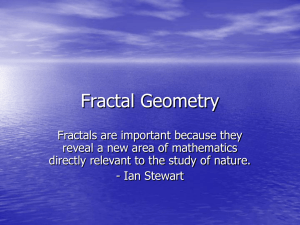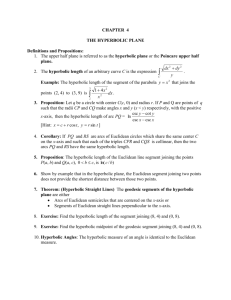In Class Notes
advertisement
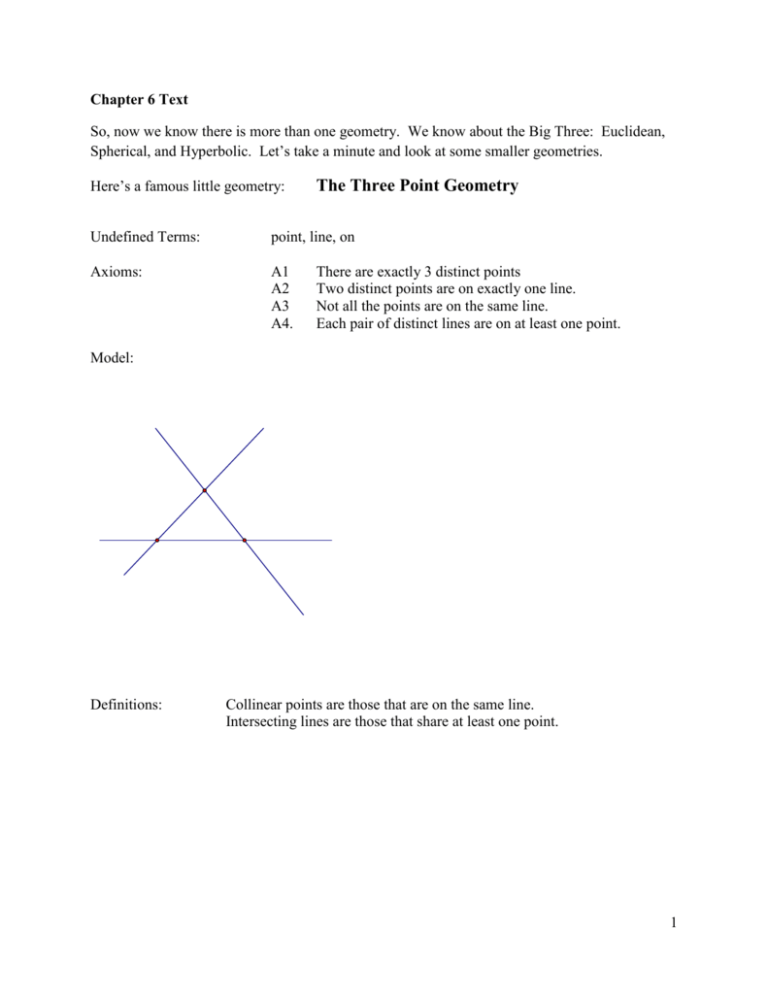
Chapter 6 Text
So, now we know there is more than one geometry. We know about the Big Three: Euclidean,
Spherical, and Hyperbolic. Let’s take a minute and look at some smaller geometries.
Here’s a famous little geometry:
The Three Point Geometry
Undefined Terms:
point, line, on
Axioms:
A1
A2
A3
A4.
There are exactly 3 distinct points
Two distinct points are on exactly one line.
Not all the points are on the same line.
Each pair of distinct lines are on at least one point.
Model:
Definitions:
Collinear points are those that are on the same line.
Intersecting lines are those that share at least one point.
1
Theorems:
Theorem 1:
Theorem 2:
Each pair of distinct lines is on exactly one point.
There are exactly 3 distinct lines in this geometry.
Proofs:
Theorem 1
Each pair of distinct lines is on exactly one point.
Let A and B be two distinct lines of the geometry. By A4, this pair is on at least one point, P1.
Suppose they are on a second point, P2. This supposition means that P1 and P2 are both on line
A and on line B. The supposition contradicts A2. So there is no such second point P2 and the
lines are on exactly one point as claimed.
Theorem 2
There are exactly 3 distinct lines in this geometry.
A1 and A2 assert that we are selecting 3 points, two at a time to be “on exactly one line.”
Using C(3,2), we have, then, that there are at least three lines (L1, L2, and L3). Suppose there is
a fourth line, L4. By Theorem 1 L4 shares one point with any other distinct line in the geometry.
In other words, there is a point on L4 that is also on each of the other three lines. This means
there are at least four points in the geometry which contradicts A1. Thus there is no such fourth
line.
Proof analysis:
These are both proofs by contradiction. When you have “exactly n” of something, the general
formula is to show how you have up to n. Then suppose one more than n and show this cannot
happen because it contradicts an axiom or a previously proved theorem.
2
How do we know this is a geometry?
What things are similar to Euclidean Geometry?
What things are ever so different?
3
The Klein Disc:
Points will be {(𝑥, 𝑦)|𝑥 2 + 𝑦 2 < 1}, the interior of the Unit Circle, and lines will be the set of all
lines that intersect the interior of this circle.
So our model is a proper subset of the Euclidean Plane.
Model:
Note that the labeled points (except H) are NOT
points in the geometry. A is on the circle not an
interior point. It is convenient to use it, though.
A
B
H
P1
P2
C
D
G
F
H is a point in the circle’s interior and IS a point
in the geometry.
We cannot list the number of lines – there are an
infinite number of them.
E
Checking the axioms:
A1
A2
A3
A4
There is exactly one line on any two distinct points.
This model is a subset of Euclidean geometry and the axiom holds.
Each line has at least two distinct points on it.
Each line has an infinite number of points by Euclidean Axioms.
There are at least three points.
The unit disc has an inifinite number of points.
Not all the points lie on the same line.
True
4
Definitions:
Parallel lines: lines that share no points are parallel.
In Euclidean Geometry, there is exactly one line through a given point not on a given line that is
parallel to the given line.
Interestingly, in this geometry there are more than two lines through a given point that are
parallel to a given line.
A
B
H
P1
P2
C
D
G
F
E
Let’s look at lines GC and GB. They intersect at
G…which is NOT a point in the geometry. So
GC and GB are parallel. In fact, they are what is
called asymptotically parallel. They really do
share no points.
Now look at P1P2. It, too, is parallel to GC.
Furthermore both P1P2 and GB pass through
point H.
P1P2 is divergently parallel to GC.
Not only is the situation vis a vis parallel lines different, we even have flavors of parallel:
asymptotic and divergent. So we are truly non-euclidean here, folks.
Theorem 1:
Theorem 2:
Theorem 3:
If two distinct lines intersect, then the intersection is exactly one point.
Inherited from Euclidean Geometry.
Each point is on at least two lines.
Each point is on an infinite number of lines.
There is a triple of lines that do not share a common point.
FE, GC, and AD for example.
5
How do we know this is a geometry?
Again, let’s discuss similarities and differences…but this time to each of Euclidean and the
Three Point Geometry.
6
Hyperbolic Geometry: Pictures and discussions:
Lines and Parallelism:
List the objects that are lines in this space. List the pairs of lines that are asymptotically parallel
and those pairs that are divergently parallel.
Poincaré Disk Model
Disk Controls
J
K
L
D
A
B
E
C
H
F
G
M
Z
N
Y
7
Triangles:
Poincaré Disk Model
Disk Controls
C
E
B
A
H
G
I
mHGI = 53.9
mGIH = 37.0
F
mGHI = 70.2
D
Radius
What are the measurements of the 6 exterior angles to GHI ?
What is the defect of the triangle?
8
Distance
Poincaré Disk Model
Disk Controls
A
Euclidean Distance
AB = 0.09 in.
Hyperbolic distance
AB = 0.53
Euclidean Distance
AB = 0.09 in.
Hyperbolic distance
AB = 0.12
B
M
Euclidean distance
N
.09
Hyperbolic distance .52
Poincaré Disk Model
Disk Controls
A
B
N
M
Euclidean distance
.09
Hyperbolic distance
.12
9
Notice that the Hyperbolic distance depends on WHERE you are in the disc. Points that are the
same Euclidean distance apart in different locations on the disc are different Hyperbolic
distances apart.
There are distance (metric) axioms in all three!
10
Poincaré Disk Model
Disk Controls
A
M
B
N
Measure the following distance in Euclidean Geometry:
AM
AN
BM
BN
11
You use these Euclidean measurements to calculate the Hyperbolic distance with a formula:
AM BN
the Hdistance from A to B is ln
AN BM
AM BN
is called the “cross product”.
AN BM
The absolute value of the natural log of the “cross product” is a very clever way to measure
distances.
What are the other 2 distance formulas?
12
Let’s look at some consequences of this formula.
Poincaré Disk Model
Disk Controls
Euclidean distances
MA = 0.86 in.
BM = 2.07 in.
AN = 1.91 in.
BN = 0.69 in.
Hyperbolic distances
MA = 35.48
HDAB
MB = 37.37
ln
MABN
BMAN
= 1.89
NA = 36.38
NB = 33.50
EG AB = 1.25 in.
A
AB = 1.89
M
B
N
Here’s a picture with Hyperbolic distances on the left and Euclidean distances on the right. The
hyperbolic distances were measured using the hyperbolic distance tool on the left and the
Euclidean distances were measured using the Euclidean distance tool on the top menu. On the
right, the calculation for Hyperbolic distance is shown. Remember that the calculation uses
Euclidean distances. The Hyperbolic tools do the calculation automatically for you.
In Euclidean Geometry the distance between points on a segment is fixed and independent of
location in the plane. In Hyperbolic Geometry, however, you have an interesting stretching of
calculated distances that depends on whether the points are close to the center of the disc or close
to the edge of the disc. Points can be the SAME Euclidean distance apart and have different
Hyperbolic distances depending on their location in the disc. This is a function of the distance
formula.
Here’s an illustration with two points that are .09 apart in Eucildean geometry and located in two
different spots in the disc. Note that the Hyperbolic distances are different and the points are
further apart out near the edge of the disc.
13
Distances:
We will use the Unit Circle, and the x-axis as our Hline.
Poincaré Disk Model
Disk Controls
C1
(-1,0)
A
(1,0)
P. Disk Center
D
E
B
P. Disk
We will find the distance from D to E using the formula. I’ll do one as an example.
If D has the Cartesian coordinates (1/3, 0) and E has the Cartesian coordinates (3/5, 0), then they
are 4/15 .267 apart in Euclidean Geometry.
DA EB
DA EB
The Hdistance from D to E is ln
= ln
DB EA
DB EA
DA is 4/3.
EB is 2/5.
DB is 2/3.
14
EA is 8/5.
Putting these together in the cross product:
4 2
3 51
2 8 2
3 5
And the absolute value of ln (.5) is approximately .69, the Hdistance.
Now, I’m going to give you 5 points. Fill in the following chart with both the Euclidean
Distances and the Hyperbolic Distances and draw a conclusion about Hyperbolic Distance and
location in the disc.
Points
Distances
P0
(0, 0)
NA
P1
(1/3, 0)
P0 to P1
P2
(3/5, 0)
P1 to P2
P3
(7/9, 0)
P2 to P3
P4
(15/17, 0)
P3 to P4
P5
(31/33, 0)
P4 to P5
Euclidean d
Hyperbolic d
What do you observe about the distances as you move further from the center of the disc?
15
More things true in all three:
Vertical angles are congruent.
F
Disk Controls
mGDI = 57.5
B
G
I
A
D
J
H
E
mEDJ = 57.5
I put
point
sI
and J
on
with
the
Eucli
dean
tool
bar
“poin
ts on arc” at the top of the page AND I measured these angles using the Hyperbolic Angle
Measure from the tool bar on the left under the double-headed arrow.
What other things are true in all 3 of the Big Three?
16
Right triangles
Disk Controls
mCDB = 90.0
C
mDCB = 17.6
mCBD = 18.1
D
B
DC = 1.81
DB = 1.79
A
CB = 2.96
Distance2+Distance2 = 6.48
Here’s a right triangle – the measures of the angles are shown. I built it using an H AB and the
Hperpendicular bisector of that line (again: Hyperbolic tools on the left menu).
= 54.3
Defect, Excess, “normal”!
Does the Pythagorean Theorem hold in Hyperbolic Geometry?
Demonstrably not – see the calculations in the sketch.
What about right triangles in the other two Big geometries?
17
Saccheri Quadrilaterals
18
Fill in the following chart
Geometry
Summit angles type
(acute, right, obtuse)
Summit to base
comparison (<, >, =)
Euclidean
Spherical
Hyperbolic
19
20

